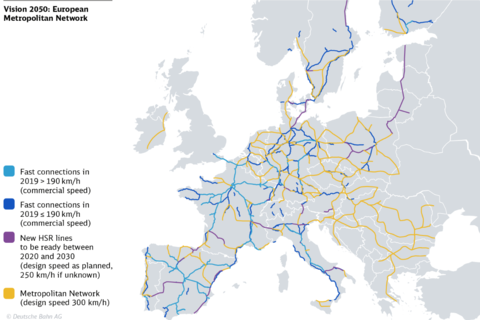PTV Modeling Reveals EU's Path to Achieve Green Deal High-Speed Train Goals
- Study for Deutsche Bahn in cooperation with several European rail operators
- PTV transportation model covers cross-border rail traffic throughout the EU for the first time
- Tripling of high-speed rail traffic possible by 2050 through infrastructure expansion
- Proposed “Metropolitan Network” includes connection of two-thirds of European citizens to HSR by 2050
As part of the Green Deal, the EU has set the target to double high-speed rail traffic by 2030 and triple it by 2050. A modelling study, that PTV Group has conducted for Deutsche Bahn (DB), simulated effects on the achievability of these targets and shows how the high-speed rail (HSR) network needs to be expanded to achieve the EU objectives.
Currently, European high-speed lines still form a patchwork of separated networks focused primarily on national traffic and characterized by different technical standards and operational models. In a joint effort with DB and a significant number of railway operators in Europe, PTV developed a travel demand model in the record time of just 5 months. It is the first model to cover cross-border high-speed and conventional rail traffic throughout the EU as well as private car, coach and air traffic. This not only opens the possibility to investigate the potential of a cohesive European high-speed rail network but also to analyze multimodal effects.
The transportation model enables accurate forecasting of how travel demand for high-speed train traffic will change due to various parameters such as population growth or reduced travel times within a better connected HSR network. The study examined the existing network together with the infrastructure expected to be built by 2030. In addition, various scenarios were simulated for the time horizon up to 2050 and considered how a ”Metropolitan Network” would have to be designed to achieve the EU's Green Deal objectives.
The modeling analysis shows that the planned infrastructure measures are not sufficient to achieve a doubling of HSR traffic by 2030. High-speed rail traffic in Europe will only grow by about 60 per cent of the envisaged growth (resulting in 175 billion passenger kilometers (pkm) of the 220 billion pkm set out in the target).
To triple HSR traffic, a crucial step is to focus on expanding the existing HSR infrastructure: This entails constructing new lines and extending the current ones to encompass approximately 21,000 additional kilometers. The entire network would almost triple from around 11,300 kilometers today (according to Eurostat 2019) to 32,000 kilometers by 2050. Two-thirds of Europe’s citizens would then be connected to the high-speed network. Shorter travel times enable much better connectivity and accessibility, and would thereby increase the appeal of rail travel for distances between 300 and 1,500 km. The simulation estimates a market share growth of over 10 percentage points by 2050, while private motorized transport would lose a significant market share.
“We are proud to have developed this groundbreaking study together with DB and the other European rail operators. With our multimodal model, that covers all of Europe for the first time, we were able to show the precise course of action required to attain the European Union's Green Deal objectives in high-speed rail traffic”, said Christian U. Haas, CEO of PTV Group, a part of the brand Umovity. “Modelling and simulation play a pivotal role in providing answers to significant questions of our time. They help taking the best decision based on facts and investing in sustainable and efficient mobility.”
Sophie Buyse, Head of Market Management international long-distance transport at DB: “Our market-based study shows that a significant expansion of the rail infrastructure will make it possible to triple high-speed traffic by 2050. The proposed Metropolitan Network will significantly shorten travel times between major European cities. As a result, the necessary modal shift to rail will become attractive to more and more people. Many new regions will be connected to the high-speed rail network and Europe will grow together - climate-friendly by rail.”
From the results of the study, DB proposes a concrete EU-wide expansion of the high-speed rail network – the so called “Metropolitan Network” –, which will connect approximately 230 metropolitan regions and major cities in Europe to the HRS at least every hour. You’ll find the entire study online.
PTV Rail Summit 2023
PTV will organize the first international industry meeting for decision-makers, chief modelers, directors, consultants, and planners in the rail sector: October 10-11
Frankfurt, Germany. For more information: https://lp.myptv.com/en/ptv-rail-summit-2023
Media Assets

Vision 2050: European Metropolitan Network
